Azure Data Explorer is a fast and highly scalable data exploration service for log and telemetry data. To use Azure Data Explorer, you first create a cluster and then create one or more databases in that cluster. This article covers how to create a free cluster and database or create a full cluster and a database. To decide which is right for you, check the feature comparison.
In this article, the full cluster is created in the Azure portal. You can also create a full cluster and database using C#, Python, Go, the Azure CLI, PowerShell, or an Azure Resource Manager (ARM) template. For more information, see Create a cluster and database.
For information on cluster subscription limits, see Azure Data Explorer limits.
Prerequisites
The prerequisites vary whether creating a free or full cluster. Select the relevant tab.
A Microsoft account or a Microsoft Entra user identity to create a free cluster. You don't need an Azure subscription or credit card.
Create a cluster
Select the relevant tab to learn how to create a free or full cluster.
To create a free cluster:
Go to My Cluster and select Create cluster.
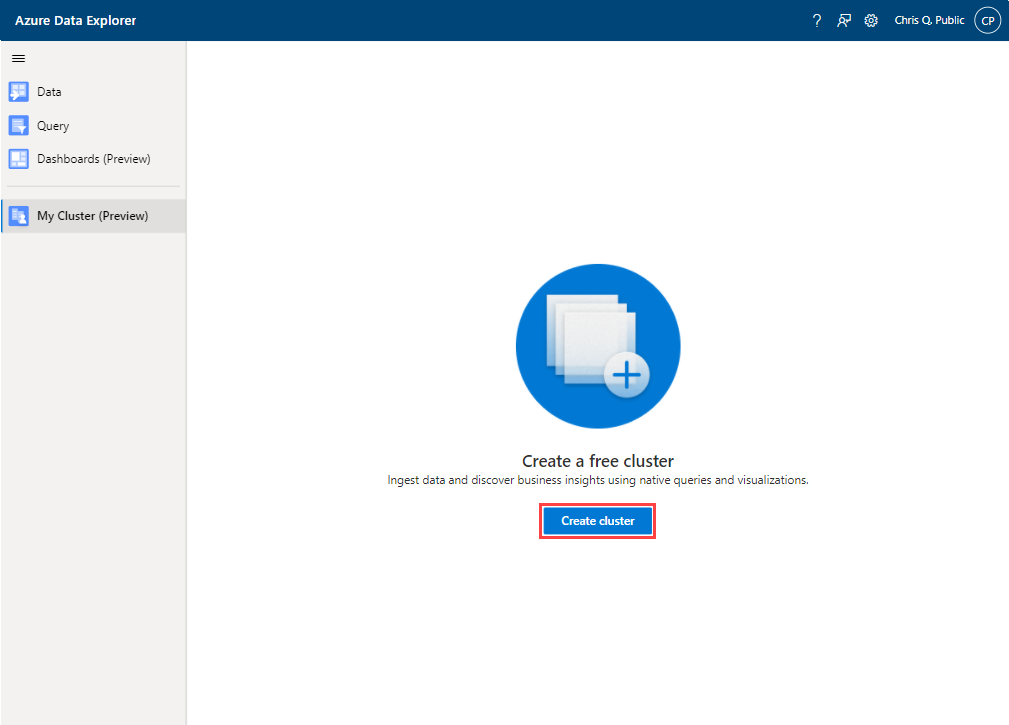
In the Create a free cluster dialog, fill out the cluster details using the following information.
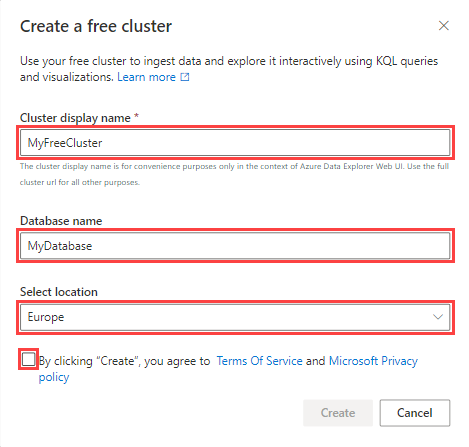
| Setting |
Suggested value |
Description |
| Cluster display name |
MyFreeCluster |
The display name for your cluster. A unique cluster name will be generated as part of the deployment and the domain name [region].kusto.windows.net is appended to it. |
| Database name |
MyDatabase |
The name of database to create. The name must be unique within the cluster. |
| Select location |
Europe |
The location where the cluster will be created. |
Review the terms of service and accept them by selecting the corresponding checkbox.
Select Create to provision the cluster. Provisioning typically takes a few minutes.
Create an Azure Data Explorer cluster with a defined set of compute and storage resources in an Azure resource group.
Select the + Create a resource button in the upper-left corner of the portal.

Search for Azure Data Explorer.
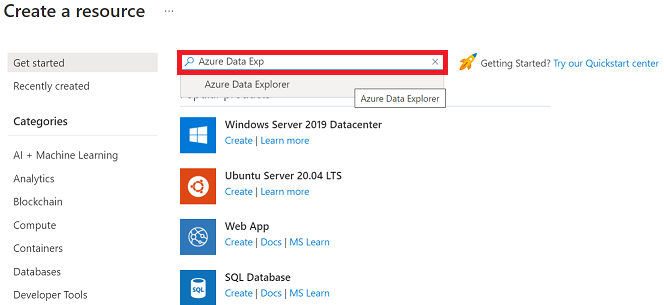
Under Azure Data Explorer, select Create.
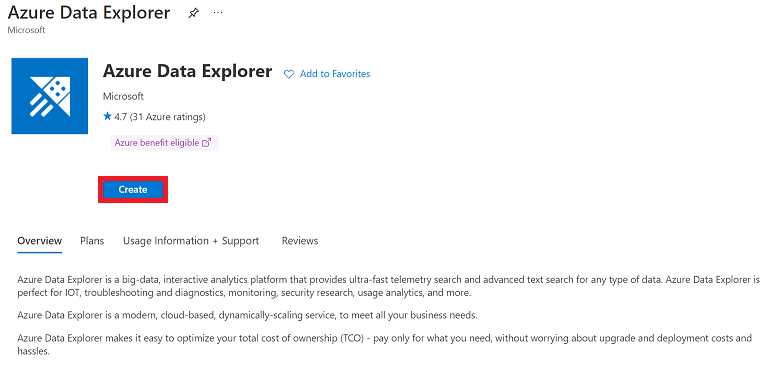
Fill out the basic cluster details with the following information.
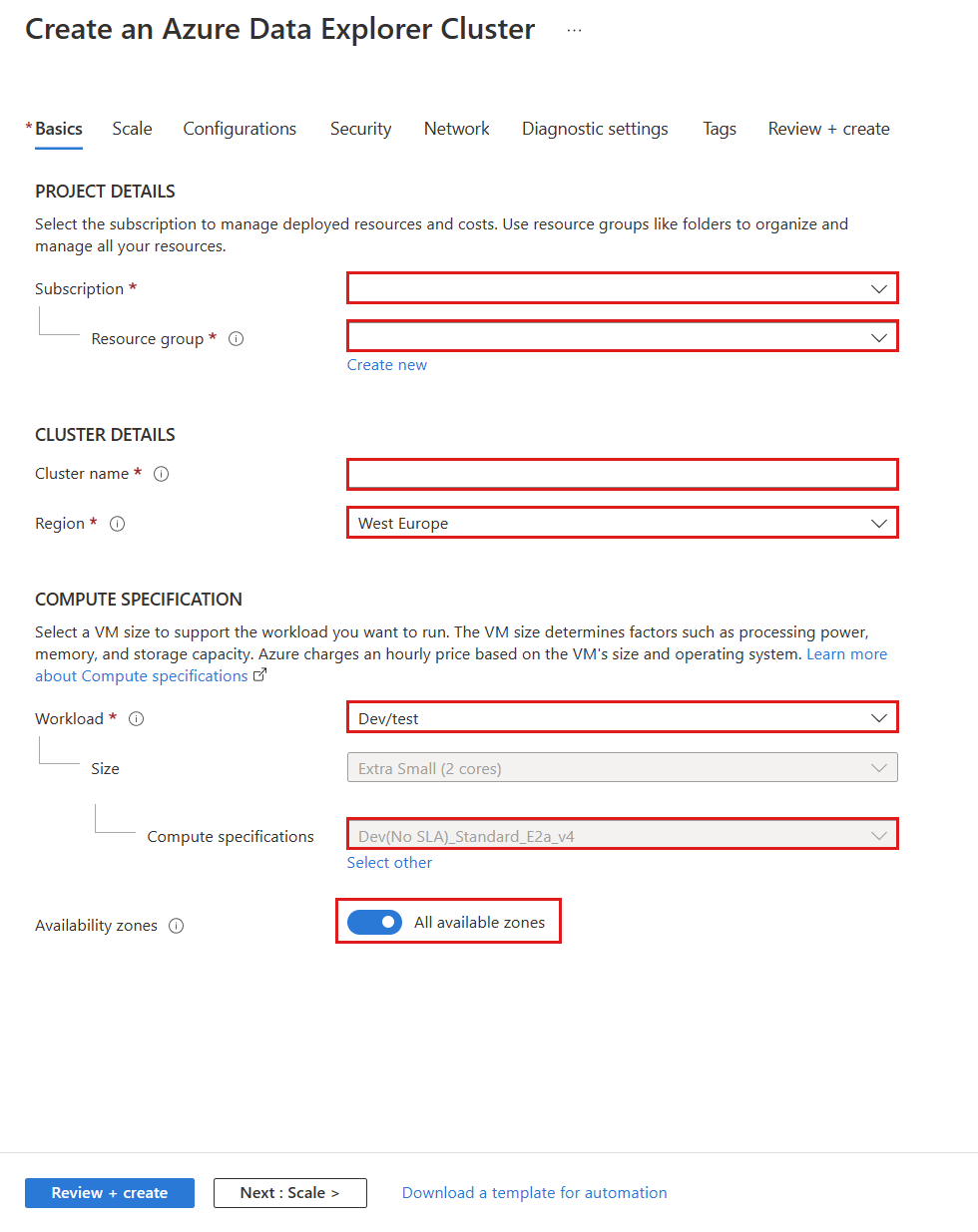
| Setting |
Suggested value |
Field description |
| Subscription |
Your subscription |
Select the Azure subscription that you want to use for your cluster. |
| Resource group |
Your resource group |
Use an existing resource group or create a new resource group. |
| Cluster name |
A unique cluster name |
Choose a unique name that identifies your cluster. The domain name [region].kusto.windows.net is appended to the cluster name you provide. The name can contain only lowercase letters and numbers. It must contain from 4 to 22 characters. |
| Region |
West US or West US 2 |
Select West US or West US 2 (if using availability zones) for this quickstart. For a production system, select the region that best meets your needs. |
| Workload |
Dev/Test |
Select Dev/Test for this quickstart. For a production system, select the specification that best meets your needs. |
| Compute specifications |
Dev(No SLA)_Standard_E2a_v4 |
Select Dev(No SLA)_Standard_E2a_v4 for this quickstart. For a production system, select the specification that best meets your needs. |
| Availability zones |
On |
Turning on this feature distributes the cluster storage and compute resources across multiple physical zones within a region for added protection and availability. By default, this feature is turned on if zones are supported in the region. If fewer than three zones are available for the compute instances, the portal displays the number of supported zones. Deployment to availability zones is possible when creating the cluster or can be migrated later. Read more about Azure Availability Zones. |
Select Review + create to review your cluster details, and on the next screen select Create to provision the cluster. Provisioning typically takes about 10 minutes.
When the deployment is complete, select Go to resource.

Note
If the deployment fails with the error "SubscriptionNotRegistered", retry the operation.
Deployment fails when the Kusto resource provider isn't registered on the subscription described in Azure resource providers and types. When the deployment fails, the Kusto resource provider registers itself on the subscription, and the retry can then succeed.
Create a database
Select the relevant tab to learn how to create a database within your cluster.
To create a database in your free cluster:
Open the Azure Data Explorer web UI.
From the left menu, select My cluster.
Under Actions, find the Create database panel. Then, select Create.
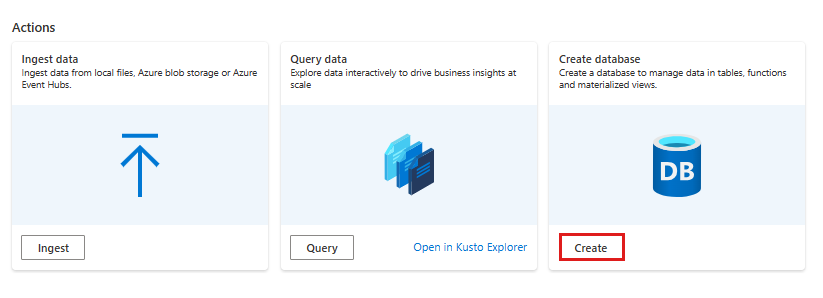
Enter a name for the database. Select Next: Create Database.
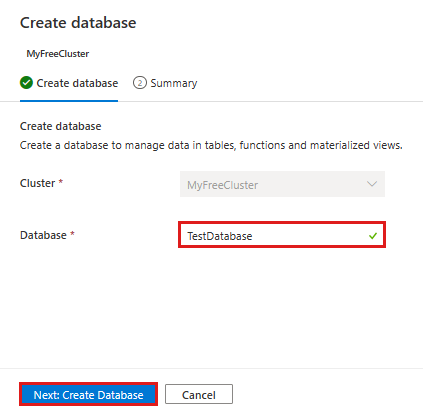
To create a database in your full cluster:
Go to your cluster in the Azure portal.
On the Overview tab, select Create database.
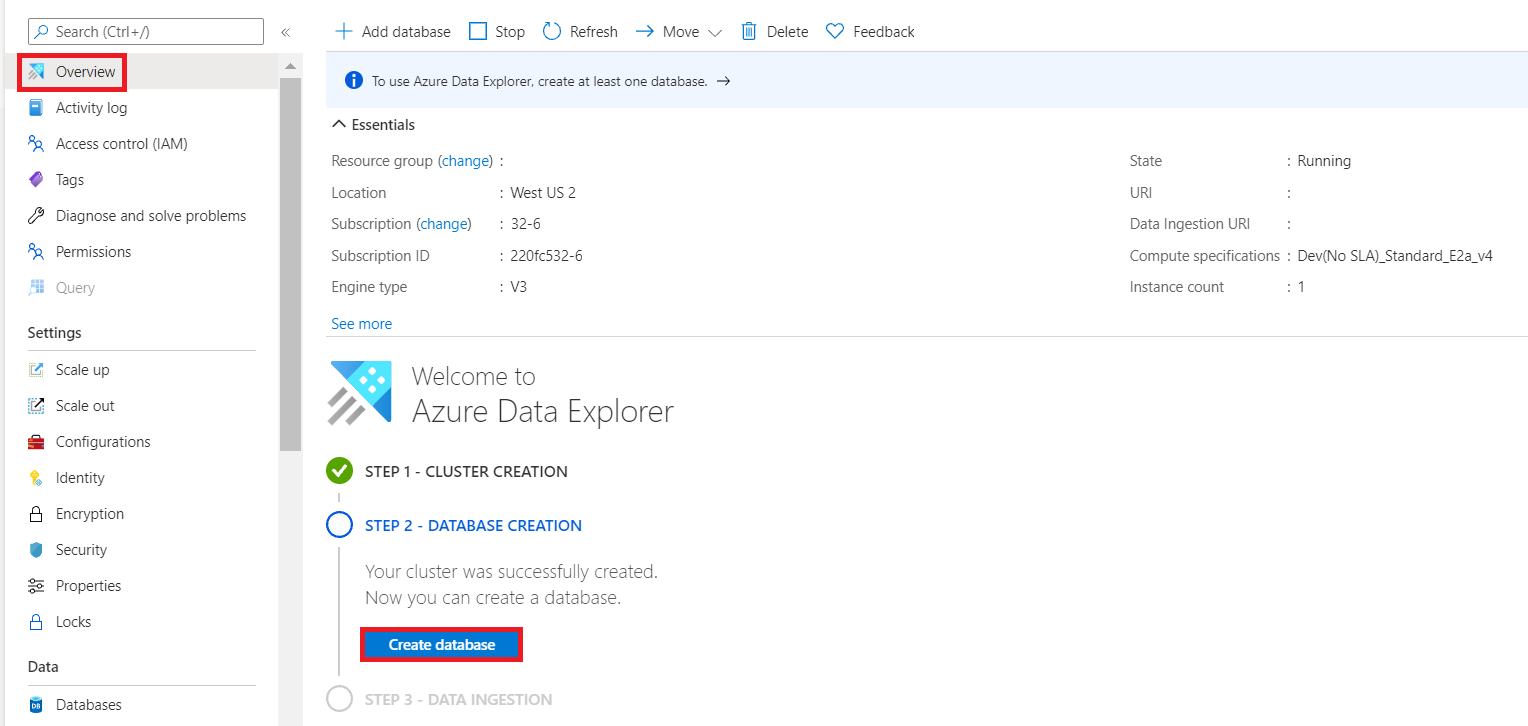
Fill out the form with the following information.
| Setting |
Suggested value |
Field description |
| Admin |
Default selected |
The admin field is disabled. New admins can be added after database creation. |
| Database name |
TestDatabase |
The name of database to create. The name must be unique within the cluster. |
| Retention period |
365 |
The number of days that data is available for querying. The period is measured from the time data is ingested. |
| Cache period |
31 |
The number of days to keep frequently queried data available in SSD storage or RAM to optimize querying. |
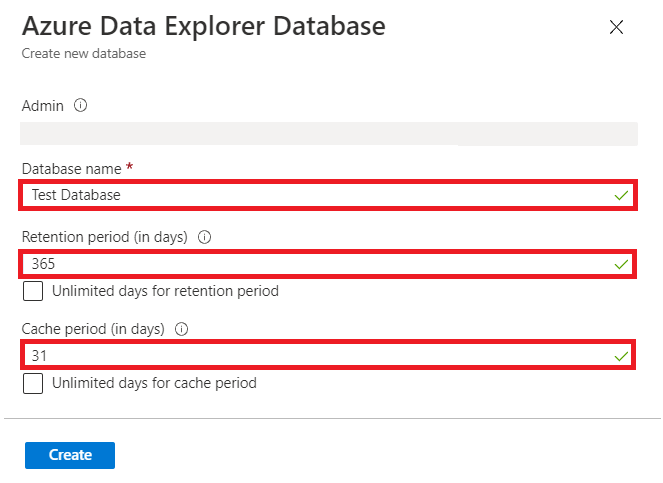
Select Create to create the database. Creation typically takes less than a minute. When the process is complete, you're back on the cluster Overview tab.
Run commands in the database
After you created the cluster and database, you can run queries and commands. The database doesn't have data yet, but you can still see how the tools work.
Under Actions, find the Query data panel. Then, select Query. Paste the command .show databases into the query window, then select Run. The result set shows TestDatabase, the only database in the cluster.
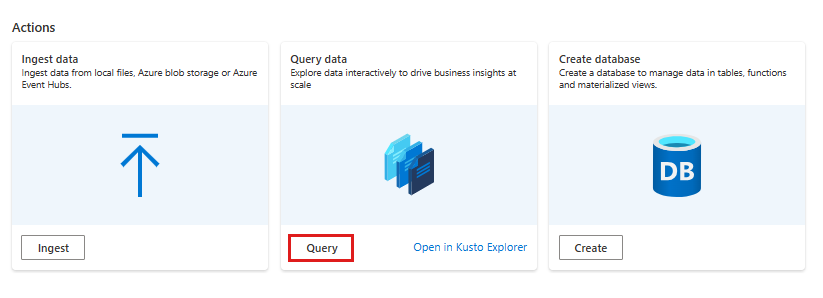
Paste the command .show tables into the query window and select Run. This command returns an empty result set because you don't have any tables yet. You'll add a table in the next article in this series.
Under your cluster, select Query. Paste the command .show databases into the query window, then select Run.

The result set shows TestDatabase, the only database in the cluster.
Paste the command .show tables into the query window and select Run.
This command returns an empty result set because you don't have any tables yet. You add a table in the next article in this series.
Stop and restart the cluster
You can't stop and restart a free cluster.
You can stop and restart a cluster depending on business needs. Stopping the cluster significantly reduces cost as it releases the compute resources, which are the bulk of the overall cluster cost, without deleting the database.
To stop the cluster, at the top of the Overview tab, select Stop.

Note
When the cluster is stopped, data isn't available for queries, and you can't ingest new data.
To restart the cluster, at the top of the Overview tab, select Start.
When the cluster is restarted, it takes about 10 minutes for it to become available (like when it was originally provisioned). It takes more time for data to load into the hot cache.
Clean up resources
To delete a database in a free cluster:
Open the Azure Data Explorer web UI.
From the left menu, select My cluster.
Under Databases, select the trash icon next to the database you'd like to delete.
If you plan to follow other quickstarts and tutorials, keep the resources you created. Otherwise, clean up your resource group, to avoid incurring costs.
In the Azure portal, select Resource groups on the far left, and then select the resource group that contains your Data Explorer cluster.
Select Delete resource group to delete the entire resource group. If using an existing resource group, you can choose to only delete the Data Explorer cluster.
Next step













